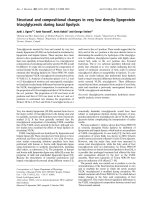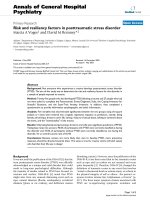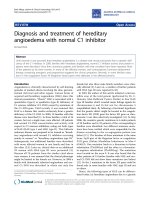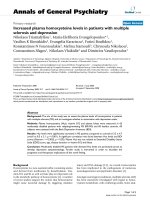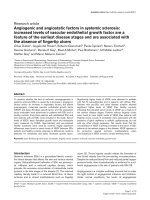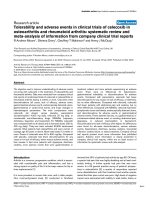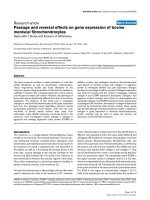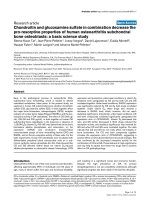Báo cáo y học: " Psychiatric and psychosocial problems in adults with normal-intelligence autism spectrum disorders" pdf
Bạn đang xem bản rút gọn của tài liệu. Xem và tải ngay bản đầy đủ của tài liệu tại đây (256.2 KB, 9 trang )
BioMed Central
Page 1 of 9
(page number not for citation purposes)
BMC Psychiatry
Open Access
Research article
Psychiatric and psychosocial problems in adults with
normal-intelligence autism spectrum disorders
Björn Hofvander*
1
, Richard Delorme
2,7
, Pauline Chaste
2,7
, Agneta Nydén
3
,
Elisabet Wentz
3,4
, Ola Ståhlberg
5
, Evelyn Herbrecht
2,6,7
, Astrid Stopin
2
,
Henrik Anckarsäter
1,2,5
, Christopher Gillberg
3
, Maria Råstam
8
and
Marion Leboyer
2,6,7,9
Address:
1
Forensic Psychiatry, Department of Clinical Sciences, Malmö, Lund University, Lund, Sweden,
2
INSERM, U 995, dept of Genetics, Institut
Mondor de Recherche Biomédicale, Psychiatry Genetics, Creteil, France,
3
Child and Adolescent Psychiatry, Institute of Neuroscience and
Physiology, University of Gothenburg, Gothenburg, Sweden,
4
Vårdal Institute, Swedish Institute for Health Sciences, Lund, Sweden,
5
Forensic
Psychiatry, Institute of Neuroscience and Physiology, University of Gothenburg, Gothenburg, Sweden,
6
Assistance Publique-Hôpitaux de Paris,
Henri Mondor-Albert Chenevier Hospitals, Department of Psychiatry, Creteil, France,
7
Fondation FondaMental, Creteil, France,
8
Department of
Clinical Sciences, Lund, Child and Adolescent Psychiatry, Lund University, Lund, Sweden and
9
University Paris 12, Faculty of Medicine, IFR10,
Creteil, France
Email: Björn Hofvander* - ; Richard Delorme - ;
Pauline Chaste - ; Agneta Nydén - ; Elisabet Wentz - ;
Ola Ståhlberg - ; Evelyn Herbrecht - ; Astrid Stopin - ;
Henrik Anckarsäter - ; Christopher Gillberg - ;
Maria Råstam - ; Marion Leboyer -
* Corresponding author
Abstract
Background: Individuals with autism spectrum disorders (ASDs) often display symptoms from
other diagnostic categories. Studies of clinical and psychosocial outcome in adult patients with
ASDs without concomitant intellectual disability are few. The objective of this paper is to describe
the clinical psychiatric presentation and important outcome measures of a large group of normal-
intelligence adult patients with ASDs.
Methods: Autistic symptomatology according to the DSM-IV-criteria and the Gillberg & Gillberg
research criteria, patterns of comorbid psychopathology and psychosocial outcome were assessed
in 122 consecutively referred adults with normal intelligence ASDs. The subjects consisted of 5
patients with autistic disorder (AD), 67 with Asperger's disorder (AS) and 50 with pervasive
developmental disorder not otherwise specified (PDD NOS). This study group consists of subjects
pooled from two studies with highly similar protocols, all seen on an outpatient basis by one of
three clinicians.
Results: Core autistic symptoms were highly prevalent in all ASD subgroups. Though AD subjects
had the most pervasive problems, restrictions in non-verbal communication were common across
all three subgroups and, contrary to current DSM criteria, so were verbal communication deficits.
Lifetime psychiatric axis I comorbidity was very common, most notably mood and anxiety
disorders, but also ADHD and psychotic disorders. The frequency of these diagnoses did not differ
between the ASD subgroups or between males and females. Antisocial personality disorder and
Published: 10 June 2009
BMC Psychiatry 2009, 9:35 doi:10.1186/1471-244X-9-35
Received: 5 January 2009
Accepted: 10 June 2009
This article is available from: />© 2009 Hofvander et al; licensee BioMed Central Ltd.
This is an Open Access article distributed under the terms of the Creative Commons Attribution License ( />),
which permits unrestricted use, distribution, and reproduction in any medium, provided the original work is properly cited.
BMC Psychiatry 2009, 9:35 />Page 2 of 9
(page number not for citation purposes)
substance abuse were more common in the PDD NOS group. Of all subjects, few led an
independent life and very few had ever had a long-term relationship. Female subjects more often
reported having been bullied at school than male subjects.
Conclusion: ASDs are clinical syndromes characterized by impaired social interaction and non-
verbal communication in adulthood as well as in childhood. They also carry a high risk for co-
existing mental health problems from a broad spectrum of disorders and for unfavourable
psychosocial life circumstances. For the next revision of DSM, our findings especially stress the
importance of careful examination of the exclusion criterion for adult patients with ASDs.
Background
Autism spectrum disorders (ASDs) (or pervasive develop-
mental disorders (PDDs), in the DSM-IV) are impairing
developmental disorders characterized by aberrations in
the domains of social interaction, communication and
stereotyped or repetitive behavior patterns, estimated to
affect about 1% of the general population [1]. The DSM-
IV includes the following ASDs: autistic disorder (AD)
(pervasive problems/deficits in all three domains),
Asperger's disorder (AS) (pervasive deficits in social inter-
action and in behaviours in the presence of a normal ver-
bal development) and pervasive developmental disorder
not otherwise specified (PDD NOS). Research criteria for
AS by Gillberg & Gillberg (G & G) [2] include the same
triad of restrictions but also verbal peculiarities and
abnormal motor development. "High-functioning
autism" (HFA) is a disputed term sometimes used to
describe individuals with AD without concomitant men-
tal retardation [3].
Community-based studies show highly skewed
male>female ratios for ASDs [4]. Possible sex differences
in the clinical phenotypes have been insufficiently studied
[5], and instruments and criteria have been developed and
validated mostly on male subjects, which also might have
affected the estimated sex ratio. Further, ASDs have
mainly been diagnosed among children and adolescents,
but increasing attention is directed to their prevalence and
clinical presentation among adults. A few long-term pro-
spective follow-up studies have so far shown high diag-
nostic stability [6,7].
Data on psychosocial life circumstances and psychiatric
comorbidity in normal-intelligence adult patients with
ASDs are scarce but suggest reduced social functioning,
and a substantially better outcome in AS than in autism,
probably attributable to better intellectual abilities [7].
Estimated rates of co-existing psychiatric disorders in sub-
jects with normal intelligence ASDs have varied substan-
tially, from 9% to 89% [8]. Attention deficits and
hyperactivity have been shown to be common in children
with ASDs [4], but studies of the co-occurrence of ADHD
and ASDs in adults are few [9,10]. A high rate of chronic
tic disorders has been reported in ASD patients [11].
Mood disorders, together with anxiety disorders, have
been described as important complications of ASDs in a
range of studies [8,12,13].
Autism was until the 1970's conceptualized as the earliest
manifestation of schizophrenia [14]. Kolvin [15], among
others, provided evidence of a bimodal distribution of
onset in "childhood psychosis", which was thought to
separate the two conditions. It was even suggested that at
least the childhood-onset subtype of schizophrenia was
less common in autism than in the general population
[16]. Today, autism and schizophrenia are referred to as
early and late onset neurodevelopmental disorders [17].
Psychotic symptoms in ASD patients have often come to
be regarded as misattributions of autistic phenomena
[18]. However, "schizophrenic-type illnesses" represent
around one-tenth of all psychiatric comorbid diagnoses in
a review by Howlin [8]. Additionally, a number of clinical
case reports have described psychotic symptomatology,
including auditory hallucinations, paranoid ideas, or
delusional thoughts in subjects with ASDs. It seems prob-
able that ASD is one possible vulnerability factor for the
development of psychotic symptoms and schizophrenia
[19]. A more definitive picture of the life-time prevalences
of ASD, psychotic disorders and their overlap will require
population-based prospective studies.
We have compiled detailed data on a large group of con-
secutively referred adults diagnosed with normal-intelli-
gence ASDs to: 1. detail the criteria for the various
problem types in the DSM-IV ASD subgroups and
between male and female subjects. 2. estimate frequencies
of DSM-IV axis I and II diagnoses and describe their diag-
nostic overlap in adults with normal-intelligence ASDs
and 3. explore the psychosocial situation for these sub-
jects.
Methods
Participants in this study were consecutively referred
adults with possible childhood-onset neuropsychiatric
disabilities at the Henri Mondor-Albert Chenevier hospi-
tal in Paris ("the Paris study group") and at the Child Neu-
ropsychiatric Clinic in Gothenburg ("the Gothenburg
study group") who subsequently met DSM-IV criteria for
BMC Psychiatry 2009, 9:35 />Page 3 of 9
(page number not for citation purposes)
an ASD with normal intelligence. Both clinics are expert
diagnostic centers focused on neuropsychiatric assess-
ments of childhood-onset disorders in adults. The Paris
site was specifically recruiting patients with AS and other
ASDs. For this study, eight patients were also included
according to the Paris protocol at the Psychiatric Outpa-
tient Clinic in Malmö.
The total study group of 122 adults (39 from Paris and 83
from Gothenburg) included 82 (67%) men and 40 (33%)
women (median age 29 years (yrs), ranging from 16 to 60
yrs). The Gothenburg subjects were significantly older
than the Paris subjects (Mann-Whitney U = 1072, p =
0.003) with a median age of 30 yrs (range 19–60 yrs) as
compared to 25 yrs (range 16–47 yrs) in Paris. There were
no significant differences in sex ratios (χ
2
= 1.33, df = 1, p
= 0.30) or full scale IQ (Mann-Whitney U = 1170, p =
0.46) between the two study groups. In Gothenburg 2%
of cases were diagnosed with AD, 46% with AS and 52%
with PDD NOS. Among the Paris subjects, AD was diag-
nosed in 8%, AS in 74%, and PDD NOS in 18%. The dif-
ference in frequency of AS and PDD NOS diagnoses
between Gothenburg and Paris were significant (χ
2
= 8.75,
df = 1, p = 0.004 and χ
2
= 12.58, df = 1, p < 0.001). Men
and women in the total study group did not differ signifi-
cantly in age (Mann-Whitney U = 1392, p = 0.18) with the
median age being 28 yrs for men and 30 yrs for women.
Sex differences within the diagnostic ASD subgroups did
not reach significance, as was the case in another study of
an adult psychiatric population [10].
The Gothenburg study group includes patients diagnosed
with ASD from a previously described study group of
adults with childhood-onset neuropsychiatric disorders
[9,20]. All subjects were seen on an outpatient basis by cli-
nicians involved in autism research (all included patients
had their final diagnoses confirmed by either HA, MR or
ML). The individual diagnoses were based on all available
information, including current clinical status. Childhood
developmental problems were assessed retrospectively,
from direct parental report where possible. More than half
of the subjects had earlier been diagnosed with anxiety,
mood disorders or psychosis and were now secondary or
tertiary referrals from specialists in adult psychiatry for
additional diagnostic work-up. Childhood medical
records, including previous psychiatric or psychological
assessments, were provided by the patients or obtained
from child medical centers. All subjects were included
according to the research protocol for the Gothenburg
Neuro-Psychiatry Genetics Project (NPG) or the Paris
Autism Research International Sibpair study (P.A.R.I.S.).
The Asperger Syndrome Diagnostic Interview (ASDI) [21]
was used in 106 subjects (87%). ASD diagnoses were
assigned according to specific assessments of all DSM-IV
autistic disorder criteria and the Gillberg & Gillberg
(G&G) criteria for AS [2]. In the Gothenburg group, 63
patients (76%) had axis-I disorders assessed by the Struc-
tured Clinical Interview for DSM IV – Axis I Disorders
(SCID-I) [22]; all other subjects had a structured, DSM-IV-
based, clinical interview supplemented with a life-time
DSM-IV symptom checklist containing individual criteria
or symptom definitions for all relevant axis-I disorders.
Axis-II disorders were assessed in 117 patients (96%), in
95 subjects (81%) by the Structured Clinical Interview for
DSM IV – Axis II Personality Disorders (SCID-II) [23] and
in the others by a structured DSM-IV-based clinical inter-
view. For all disorders, DSM criteria that limited the pos-
sibility of assigning other comorbid psychiatric diagnoses
were disregarded to allow a comprehensive recording of
the pattern of comorbidity.
Somatic status was assessed in all patients. Cases with
known medical causes of autism, including genetic syn-
dromes, or injuries of relevance for the mental disorders
assessed, were excluded by history, physical examination,
and in dubious cases by karyotype, Fragile × PCR and
southern blot, and FISH analyses (15q11-q13, 22q11 and
22q13 deletion syndromes). No patient was in need of
language interpretation for communication. Three-gener-
ation pedigrees were drawn. In the Gothenburg study
group, whenever possible, a semi-structured collateral
interview (n = 63, 76%) based on the ASDI, the ADHD-RS
[24], the "Five to Fifteen" questionnaire [25], and the
Wender Utah Rating Scale [26] was performed with a rel-
ative who had known the index subject as a child. In the
Paris study group the Autism-Tics, ADHD and Other
Comorbidities Inventory (A-TAC) [27], was used for col-
lateral interviews (n = 39, 100%). Global intellectual abil-
ity was assessed in most cases (n = 114, 93%) using the
Wechsler Adult Intelligence Scale-Revised (WAIS-R) (n =
83) or the Wechsler Adult Intelligence Scale-III (WAIS-III)
(n = 31) [28,29]. The remaining eight subjects either had
normal results from previous tests or well-documented
normal development according to school and educational
performance but declined participation in new psycho-
metric assessments.
The study was approved by the medical ethical review
boards at each site (Gothenburg, Paris and Malmö). All
patients included gave written informed consent.
Statistical analyses were performed using the SPSS 15.0
[30]. Since AD was diagnosed only in five subjects, these
subjects were described separately and not included in
group comparisons between diagnostic groups. Mann-
Whitney U test was used for group comparisons of differ-
ences in continuous variables, as the data was not nor-
mally distributed. Fisher's exact χ
2
-test was used to
compare differences in frequencies of fulfilled ASD, DSM-
BMC Psychiatry 2009, 9:35 />Page 4 of 9
(page number not for citation purposes)
IV and G & G criteria and coexisting psychopathologies.
All p-values are two-tailed, and significance was consid-
ered at the 5% level.
Results
Autism Spectrum Disorders (Pervasive Developmental
Disorders)
The distribution of DSM-IV and G & G criteria across the
diagnostic categories and sexes is presented in Table 1. Vir-
tually all subjects (n = 119, 98%) displayed symptoms
required for the first DSM-IV and G & G criterion (i.e.
social interaction problems, in the DSM-IV also including
non-verbal communication deficits). Nonverbal commu-
nication problems according to the fifth G & G criterion
were very common, described in 89% (n = 108) of all sub-
jects. The AS and the PDD NOS subjects did not differ sig-
nificantly in the DSM-IV and G & G areas of social
interaction and the DSM-IV area of communication.
Other Axis I Psychiatric Disorders "Usually First Diagnosed
in Infancy, Childhood, or Adolescence"
A large proportion of all subjects was diagnosed with
ADHD (n = 52, 43%, Table 2). Subjects with PDD NOS
had significantly more symptoms of inattention (Mann-
Whitney U = 1157, p = 0.01) and hyperactivity/impulsiv-
ity (Mann-Whitney U = 1136, p = 0.007) compared to
subjects with AS. However, the prevalence of the categori-
cal diagnosis of ADHD did not differ significantly
between the groups.
The frequency of reading disorder in combination with
disorder of written expression (i.e. dyslexia) was 14% (n =
Table 1: Distribution of DSM-IV and Gillberg and Gillberg (G&G) criteria across the diagnostic categories
Type of DSM-IV PDD Autistic disorder
(N=5)
Asperger's disorder
(N=67)
PDD NOS
(N=50)
AS – PDD NOS
a
Total
(N=122)
Male
(N=82)
Female
(N=40)
Male – Female
a
N% N %N%χ
2
(df = 1)
pN%N%N%χ
2
(df = 1)
p
DSM IV criterion A1
"Qualitative
impairment in social
interaction"
5 100 67 100 47 94 4.13 0.08 119 98 80 98 39 98 0.00 1.00
DSM-IV Criterion A2:
"Qualitative
impairment in
communication"
5 100 34 51 18 36 2.52 0.13 57 47 41 50 16 40 1.08 0.34
DSM-IV Criterion A3:
"Restricted, repetitive
and stereotyped
behaviour, interests,
and activities"
5 100 65 97 29 58 27.60 <0.001 99 81 70 85 29 73 2.91 0.14
G&G Criterion 1;
"Social interaction
problems"
5 100 67 100 47 96 4.13 0.08 119 98 80 98 39 98 0.00 1.00
G&G Criterion 2:
"Narrow interests"
5 100 64 96 33 67 17.61 <0.001 102 84 69 84 33 83 0.05 0.80
G&G Criterion 3;
"Repetitive routines"
5 100 61 91 25 51 24.77 <0.001 91 75 62 76 29 73 0.14 0.83
G&G Criterion 4:
"Speech and language"
5 100 56 84 22 45 20.19 <0.001 83 69 57 70 26 65 0.25 0.68
G&G Criterion 5:
"Non-verbal
communication
problems"
5 100 66 99 37 76 16.33 <0.001 108 89 74 90 34 85 0.73 0.38
G&G Criterion 6:
"Motor clumsiness"
5 100 57 85 31 63 8.18 0.005 94 78 60 73 33 83 1.29 0.37
a
Fisher's exact
χ
2
test
BMC Psychiatry 2009, 9:35 />Page 5 of 9
(page number not for citation purposes)
Table 2: Frequency of ADHD subtypes and symptoms of inattention and hyperactivity/impulsivity in each of the ASD subtypes
Autistic disorder
(N=5)
Asperger's disorder
(N=67)
PDD NOS
(N=50)
AS – PDD NOS
a
Total
(N=122)
Male
(N=82)
Female
(N=40)
Male – Female
a
N% N %N%χ
2
(df = 1)
p N%N%N% χ
2
(df = 1)
p
Inattentive
subtype
2 40 8 12 11 22 2.13 0.21 21 17 14 17 7 18 0.00 1.00
Hyperactive/
impulsive
subtype
0 0 5 8 3 6 0.10 1.00 8 7 5 6 3 8 0.09 0.72
Combined
subtype
0 0 11 16 12 24 1.04 0.35 23 19 16 20 7 18 0.07 1.00
Any ADHD 2 40 24 36 26 52 3.06 0.09 524335431743 0.00 1.00
AS – PDD NOS
b
Male – Female
b
Zp Zp
Median and
range of
inattentive
criteria met
4
(0–7)
3
(0–8)
6
(0–9)
-2.52 0.01 4
(0–9)
4
(0–9)
3
(0–9)
-0.49 0.63
Median and
range of
hyperactive/
impulsive
criteria met
2
(0–7)
1
(0–9)
3 (0–9) -2.69 0.007 2
(0–9)
2
(0–9)
2
(0–9)
-0.89 0.37
a
Fisher's exact
χ
2
test;
b
Mann-Whitney U test
Table 3: Lifetime rate of axis-I disorders in adults with autism spectrum disorders (N = 122, if not otherwise specified)
Criteria met DSM-IV
Autistic disorder
(N=5)
Asperger's disorder
(N=67)
PDD NOS
(N=50)
Total
(N=122)
AS – PDD NOS
a
Male
(N=82)
Female
(N=40)
Male – Female
a
N% N %N%N%χ
2
(df = 1)
pN%N% χ
2
(df = 1)
p
Attention-Deficit/
Hyperactivity
Disorder
2 40 24 36 26 52 52 43 3.06 0.09 35 43 17 43 0.00 1.00
Chronic tic disorders 0 0 14 21 11 22 25 20 0.02 1.00 20 24 5 13 2.33 0.16
Mood disorder 3 60 35 52 27 54 65 53 0.04 1.00 39 48 26 65 3.29 0.08
Psychotic disorders 0 0 10 15 5 10 15 12 0.62 0.58 13 16 2 5 2.94 0.14
Substance related
disorders
1 20 4 6 14 28 19 16 10.67 0.002 14 17 5 13 0.43 0.60
Anxiety disorder N =
119
0 0 34 51 25 50 59 50 0.01 1.00 37 45 22 55 1.05 0.34
Obsessive Compulsive
Disorder
0 0 14 21 15 30 29 24 1.27 0.29 16 20 13 33 2.50 0.12
Impulse control
disorder
0 0 4 6 7 14 11 9 2.17 0.20 6 7 5 13 0.88 0.50
Somatoform disorder
N = 119
0 0 2 3 4 8 6 5 1.48 0.40 4 5 2 5 0.00 1.00
Eating disorder N =
119
0 0 2 3 4 8 6 5 1.48 0.40 2 2 4 10 3.29 0.09
a
Fisher's exact
χ
2
test
BMC Psychiatry 2009, 9:35 />Page 6 of 9
(page number not for citation purposes)
16). In the Gothenburg group the criteria for this diagno-
sis was an unambiguous history of deficient reading and
writing; the Paris subjects had a formal diagnosis of dys-
lexia.
Adult Axis I Disorders
The frequencies of the remaining DSM-IV axis-I diagnoses
are presented in Table 3. Among the small number of sub-
jects with AD, 80% (n = 4) met criteria for at least one
other major axis-I disorder as specified below. In the AS
and PDD NOS subgroups all subjects had at least one
comorbid axis-I disorder. The most common life-time
comorbid condition was mood disorder (n = 65, 53%).
One-third of subjects (n = 42, 34%) had been treated with
an antidepressant at least once in their lives. Criteria for a
bipolar disorder (BP) were met by 10 subjects (8%), five
of whom had bipolar I subtype and two bipolar II, while
three were coded as unknown subtypes. No subject with
AD met criteria for BP. Only three patients (2%) had ever
been treated with a mood stabilizer.
A considerable number of patients (n = 15, 12%) met cri-
teria for a psychotic disorder (most often not otherwise
specified). Four patients met criteria for a schizophreni-
form disorder, three for brief psychotic disorder, and one
for a delusional disorder. No subject met criteria for
schizoaffective disorder. In the entire study group, 18 sub-
jects (15%) had been treated with neuroleptics at least
once in their lives.
Sixteen per cent of the subjects (n = 19) met criteria for a
substance use disorder (SUD). The PDD NOS group had
significantly more SUD-related diagnoses than the AS
group (p = 0.002). The majority of diagnoses were related
to alcohol (n = 15, 12%), four subjects met criteria for
cannabis use disorder, three for amphetamine use disor-
der, two had a history of taking non-prescribed opiates or
analgetics, and one had used anabolic steroids. Another
subject, a 27-year-old man with AD, had a history of
inhaling solvents.
The second most frequent category of DSM-IV disorders
was anxiety disorders. Generalized anxiety disorder was
common (n = 18, 15%) as was social phobia (n = 16,
13%). Thirteen subjects (11%) met criteria for panic dis-
order and/or agoraphobia and seven (6%) met criteria for
a specific phobia. Two patients suffered from post trau-
matic stress disorder (PTSD), and one had an anxiety dis-
order NOS.
Among patients affected with impulse control disorders,
intermittent explosive disorder was the most common
diagnosis (n = 7, 6%), followed by kleptomania, pyroma-
nia, pathological gambling, trichotillomania, and
impulse control disorder NOS, all affecting one patient
each.
Personality disorders
Rates for personality disorders (PD) according to DSM-IV
are presented in Table 4. Obsessive-compulsive PD
(OCPD) was significantly more common in the AS group
Table 4: Lifetime rate of axis-II disorders in adults with autism spectrum disorders (N = 117)
Criteria met DSM-IV
Autistic disorder
(N=5)
Asperger's disorder
(N=62)
PDD NOS
(N=50)
Total
(N=117)
AS – PDD NOS
a
Male
(N=77)
Female
(N=40)
Male – Female
a
N% N %N%N%χ
2
(df = 1) p N % N % χ
2
(df = 1) p
Personality disorders
≥ 1 PD 1 20 42 68 30 60 73 62 0.72 0.43 46 60 27 68 0.68 0.43
≥ 2 PD 0 0 25 40 16 32 41 35 0.83 0.43 28 36 13 33 0.18 0.84
≥ 3 PD 0 0 11 18 9 18 20 17 0.00 1.00 13 17 7 18 0.01 1.00
Paranoid 0 0 12 19 10 20 22 19 0.01 1.00 15 20 7 18 0.07 1.00
Schizotypal 0 0 10 16 5 10 15 13 0.90 0.41 12 16 3 8 1.54 0.26
Schizoid 0 0 13 21 12 24 25 21 0.15 0.82 11 14 14 35 6.72 0.02
Histrionic - - - - - - 00 - - - -
Narcissistic 0 0 1 2 2 4 3 3 0.61 0.59 2 3 1 3 0.00 1.00
Borderline 0 0 4 7 6 12 10 9 1.05 0.34 4 5 6 15 3.24 0.09
Antisocial 0 0 0 0 4 8 4 3 5.14 0.04 3 4 1 3 0.16 1.00
Avoidant 0 0 18 29 11 22 29 25 0.62 0.52 21 28 8 20 0.81 0.50
Dependent 0 0 2 3 4 8 6 5 1.24 0.41 3 4 3 8 0.70 0.41
Obsessive 1 20 25 40 11 22 37 32 4.26 0.04 23 30 14 35 0.32 0.68
PD NOS - - - 00- -
a
Fisher's exact
χ
2
test
BMC Psychiatry 2009, 9:35 />Page 7 of 9
(page number not for citation purposes)
(χ
2
= 4.26, df = 1, p = 0.04) and antisocial PD in the PDD
NOS group (χ
2
= 5.14, df = 1, p = 0.04). Overall frequency
of PDs did not differ between men and women, with the
exception of schizoid PD, which was significantly more
common among the female subjects (χ
2
= 6.72, df = 1, p =
0.02).
Psychosocial Characteristics
A majority of the subjects (n = 68, 56%) reported that they
had been bullied at school. Such victimization was most
common among the women (χ
2
= 6.09, df = 1, p = 0.02).
The educational level was relatively high in the entire
study population. Two thirds (n = 77, 65%) had gradu-
ated from upper secondary school, and a quarter (n = 29,
24%) had completed college or university studies. In
terms of daily occupation, 43% (n = 50) were employed
or were students at the time of the assessment, with no sig-
nificant differences between males and females. The oth-
ers had either no organized daily activities, were on sick
leave, held a medical pension, or were unemployed. Half
of the subjects aged 23 yrs or more had independent living
arrangements, as did some of the younger subjects. Nine-
teen (16%) had lived in a long-term relationship. Men
and women did not differ in terms of marriage or cohab-
itation.
Discussion
Large outcome studies or systematic clinical surveys of
adult ASDs are few. To our knowledge, this is one of the
first such studies presenting detailed clinical data on a
large consecutive group of adults with ASDs and normal
intelligence. It includes a wide age span (16–60 yrs), with
a relatively large proportion of subjects over 30 yrs of age
(42%), and a substantial representation of women.
The purpose of describing the presence of autistic disorder
symptoms in all three diagnostic subgroups was to
address the important question of the adequacy of the cur-
rent DSM-IV ASD categories. The interpretation of differ-
ent patterns of criteria in the three diagnostic groups first
has to consider that these criteria were used to assign the
diagnoses. Then, as expected, the small group with nor-
mal-intelligence AD (equivalent to HFA) had the most
pervasive ASD symptomatology, followed by the AS
group, while the PDD NOS group exhibited the least
number of symptoms. However, one-third of the PDD
NOS patients and half of the AS patients met the DSM-IV
communication criterion despite the fact that, according
to the DSM-IV, only "subtle aspects of social communica-
tion" is expected to be impaired in AS, and the criteria for
PDD NOS do not even require communication problems.
When comparing the distribution of G & G criteria across
the subgroups, deficits in the area of "social interaction"
were evident in all ASD cases, while the other criteria were
all more pronounced in the AS group as compared to the
PDD NOS group. A tentative conclusion would be that
these findings fit a dimensional model of ASDs and that
the high rates for all criteria across the diagnostic catego-
ries would speak against their use as differential diagnos-
tic entities.
The proportion of female subjects was high in this consec-
utively recruited clinical group compared to epidemiolog-
ical studies [4]. This high representation could suggest
that women with ASDs develop more severe social deficits
[31] or more concomitant psychopathology. In a group of
children and young adults diagnosed with normal-intelli-
gence ASDs, Holtmann and colleagues [5] did not find sex
differences in the triad of autism core dysfunctions. Our
findings can extend this to an older group of patients.
It is worth noting that referral practices are likely to have
enriched our study group with a higher prevalence of
comorbid conditions in comparison to the ASD popula-
tion as a whole. Indeed, many of our patients had previ-
ously been in contact with specialists in psychiatry and
were then referred to our expert centers. The prevalence of
comorbid conditions is also likely to be inflated by our
decision to disregard DSM-IV criteria excluding certain
diagnoses in the presence of ASD. Nonetheless, this deci-
sion was justified by our aim to describe clinical condi-
tions where prevalence would have been zero if strict
hierarchical criteria had been followed.
High comorbidity with childhood-onset disorders was
expected in our study population. Despite the fact that the
current diagnostic classification of ASDs precludes a diag-
nosis of concomitant ADHD (in DSM-IV) or hyperkinetic
disorder (in ICD-10), earlier estimates have reported very
high rates of these problems (80–83%) in children with
ASDs [4]. In our group, the rate was lower but still sub-
stantial. The most common ADHD subtypes were the
combined and inattentive forms, which may be due to the
different presentation of ADHD in adulthood.
Kanner [32] suggested that the features of the autistic syn-
drome, for example insistence on sameness, were related
to anxiety. Other authors have described patients with
ASD as vulnerable to stress because of a restricted reper-
toire of appropriate coping mechanisms [33]. In agree-
ment with this, anxiety disorders, especially OCD where
rates were very similar to a recent study of mostly AS
patients [34], were clearly overrepresented as compared to
the general population.
Earlier estimates of comorbid depression in autism and
AS vary widely, from 4 to 38% [35]. Our high frequency
of major depressive disorder might be linked to the higher
median age in our study group. This finding and the fact
that only a minority of the patients had ever had antide-
BMC Psychiatry 2009, 9:35 />Page 8 of 9
(page number not for citation purposes)
pressant treatment would stress the importance of atten-
tion to such symptoms in this patient category. The
overlap of symptoms between ASDs and depression (e.g.
social withdrawal, impaired non-verbal communication)
can make diagnoses difficult, and earlier studies have
pointed out the difficulties these patients have in verbaliz-
ing their changes in mood and describing depression [36].
Psychotic symptoms in ASDs are controversial. Since our
study group was clinically recruited, it cannot be consid-
ered to be representative for a general ASD population,
but the need for revision of the criteria precluding or dif-
fusing the diagnostic possibilities in this field is obvious.
Substance-related disorders, especially those related to
alcohol, were no more common in this group than in the
general population, but more prevalent among subjects
diagnosed with a PDD NOS than among subjects with AS.
This, and the fact that antisocial PD was found only in the
PDD NOS group, is in line with other studies describing a
subgroup of antisocial individuals having atypical autistic
features presenting as PDD NOS [37]
Patients afflicted with ASDs often describe themselves in
clinical interviews or in self-rate questionnaires in a way
that corresponds to PD characteristics [38]. Our findings,
with two-thirds of our subjects meeting criteria for at least
one PD, confirm this, as well as a preponderance of OCPD
and avoidant PDs [20]. Furthermore, the higher rate of
OCPD in AS compared to PDD NOS corresponds to the
AS group's higher rate of restrictions in repertoires and
interests. However, the AS group did not have a higher
rate of OCD as compared to the PDD NOS group. Despite
the tendency toward more diagnoses of cluster A and C in
the total group, the overall conclusion is that categorical
PDs provide a rather unspecific description of the mala-
daptive patterns of personality function in the ASD group.
A large proportion of the subjects, especially the females,
had been bullied during their school years. In spite of high
levels of education, more than half of the entire ASD
group was unemployed, on sick-leave, or had a medical
pension. Some 40% were still living with their parents or
in community-based group homes. In line with previous
studies, only a few had ever had a long-term relationship
[5], though marriage or cohabitation was slightly more
common among the women. Altogether, the outcome
must be considered rather poor, taking the high intellec-
tual ability of the group into account.
Conclusion
ASDs in adulthood may be diagnosed according to criteria
reflecting the same triad of socio-communicative restric-
tions as in children. A wide range of symptoms will be
found in all ASD subgroups, questioning the current clas-
sification. Patterns of comorbidity are insufficiently
described in adult patients with ASD. This study demon-
strated the high rates of DSM-IV axis I and II disorders,
especially depression and ADHD. Differences between
men and women were very few. Our results reflect the
indistinct demarcations of the adult clinical neurodevel-
opmental phenotypes and stress the importance of the cli-
nician's attention to a wide spectrum of psychiatric
symptoms. These findings point to the need for a careful
reexamination of the exclusion criteria of concomitant
disorders for adult patients with ASDs in the next revision
of the DSM. In spite of a normal or high intelligence,
many subjects with adult ASD have considerable psycho-
social impairment.
Limitations
This study has a number of limitations. First, the lack of
comparison group. All subjects were, however, consecu-
tively recruited, which gives the study group a representa-
tive quality. Second, in order to obtain a reasonable study
group size, two groups of patients from different sites were
pooled. The groups from the two sites were investigated
with almost, but not exactly, the same protocol. The two
groups were, however, fairly similar in important varia-
bles such as age, sex, and intellectual level.
Both study sites have been involved in a common genetic
project, and methods for assessment of subjects with
ASDs were established in 1990s. Still, frequencies of dis-
orders differed between sites: whereas subjects with AD
were rare in both sites, the frequency of Gothenburg sub-
jects with AS almost equaled that with PDD NOS, but the
large majority of the Paris subjects were diagnosed with
AS.
Our study group is most likely representative of clinical
patients in adult psychiatry, though some prevalences of
comorbid psychiatric symptoms may have been overesti-
mated due to the fact that many of these patients had ear-
lier psychiatric contacts. There is a need for population-
based studies of ASDs and their overlapping conditions in
adults.
Competing interests
The authors declare that they have no competing interests.
Authors' contributions
BH, PC, HA,OS, CG, MR and ML designed this study and
its protocols. BH, RD, PC, AN, EW, OS, EH, AS, HA, MR
and ML collected data through their clinical work. BH per-
formed the statistical analyses and wrote the manuscript
together with RD, HA, CG, MR and ML. All authors read
and approved the final manuscript.
BMC Psychiatry 2009, 9:35 />Page 9 of 9
(page number not for citation purposes)
Acknowledgements
The authors thank MJ Pereira Gomes, E Abadie, M Fabbro, R Bruckert, A
Brimse, Å Holl, A Larsson, A Yngvesson Rastenberger and M Montell for
technical assistance. We also thank our patients and their families for their
participation.
This work was supported by INSERM, Assistance Publique des Hôpitaux de
Paris, Fondation orange (grant attributed to AS), RTRS Santé Mentale
(Foundation FondaMental), The Swedish Inheritance Fund, Region Skåne,
Landstinget Kronoberg, the Swedish Research Council (VR), Stiftelsen
Lindhaga and Stiftelsen Professor Bror Gadelius Minnesfond.
References
1. Kadesjo B, Gillberg C, Hagberg B: Brief report: autism and
Asperger syndrome in seven-year-old children: a total popu-
lation study. J Autism Dev Disord 1999, 29:327-331.
2. Gillberg IC, Gillberg C: Asperger syndrome – some epidemio-
logical considerations: a research note. J Child Psychol Psychiatry
1989, 30:631-638.
3. Howlin P: Outcome in high-functioning adults with autism
with and without early language delays: implications for the
differentiation between autism and Asperger syndrome. J
Autism Dev Disord 2003, 33:3-13.
4. Ehlers S, Gillberg C: The epidemiology of Asperger syndrome.
A total population study. J Child Psychol Psychiatry 1993,
34:1327-1350.
5. Holtmann M, Bolte S, Poustka F: Autism spectrum disorders: sex
differences in autistic behaviour domains and coexisting psy-
chopathology. Dev Med Child Neurol 2007, 49:361-366.
6. Billstedt E, Gillberg IC, Gillberg C: Autism after adolescence:
population-based 13- to 22-year follow-up study of 120 indi-
viduals with autism diagnosed in childhood. J Autism Dev Disord
2005, 35:351-360.
7. Cederlund M, Hagberg B, Billstedt E, Gillberg IC, Gillberg C:
Asperger syndrome and autism: a comparative longitudinal
follow-up study more than 5 years after original diagnosis. J
Autism Dev Disord 2008, 38:72-85.
8. Howlin P: Outcome in adult life for more able individuals with
autism or Asperger syndrome. Autism 2000, 4:63-83.
9. Stahlberg O, Soderstrom H, Rastam M, Gillberg C: Bipolar disor-
der, schizophrenia, and other psychotic disorders in adults
with childhood onset AD/HD and/or autism spectrum disor-
ders. J Neural Transm 2004, 111:891-902.
10. Rydén E, Bejerot S: Autism spectrum disorders in an adult psy-
chiatric population. A naturalistic cross-sectional controlled
study. Clinical Neuropsychiatry 2008, 5:13-21.
11. Canitano R, Vivanti G: Tics and Tourette syndrome in autism
spectrum disorders.
Autism 2007, 11:19-28.
12. Wing L: Asperger's syndrome: a clinical account. Psychol Med
1981, 11:115-129.
13. Ghazziuddin M, Zafar S: Psychiatric comorbidity of adults with
autism spectrum disorders. Clinical Neuropsychiatry 2008, 5:9-12.
14. Volkmar FR, Cohen DJ: Comorbid association of autism and
schizophrenia. Am J Psychiatry 1991, 148:1705-1707.
15. Kolvin I: Studies in the childhood psychoses. I. Diagnostic cri-
teria and classification. Br J Psychiatry 1971, 118:381-384.
16. Burd L, Kerbeshian J: A North Dakota prevalence study of
schizophrenia presenting in childhood. J Am Acad Child Adolesc
Psychiatry 1987, 26:347-350.
17. Goldstein G, Minshew N, Allen D, Seaton B: High functioning
autism and schizophrenia. A comparison of an early and late
onset neurodevelopmental disorder. Archives of Clinical Neu-
ropsychology 2002, 17:461-475.
18. Dossetor DR: 'All that glitters is not gold': misdiagnosis of psy-
chosis in pervasive developmental disorders – a case series.
Clin Child Psychol Psychiatry 2007, 12:537-548.
19. Nylander L: Autism spectrum disorders and schizophrenia
spectrum disorders – is there a connection? A literature
review and some suggestions for future clinical research.
Clinical Neuropsychiatry 2008, 5:43-54.
20. Anckarsater H, Stahlberg O, Larson T, Hakansson C, Jutblad SB, Nik-
lasson L, Nydén A, Wentz E, Westergren S, Cloninger CR, Gillberg
C, Rastam M: The impact of ADHD and autism spectrum dis-
orders on temperament, character, and personality devel-
opment. Am J Psychiatry 2006, 163:1239-1244.
21. Gillberg C, Gillberg IC, Rastam M, Wentz E: The Asperger Syn-
drome (and high-functioning autism) Diagnostic Interview
(ASDI): a preliminary study of a new structured clinical
interview. Autism 2001, 5:57-66.
22. First MB: Structured clinical interview for DSM-IV axis I disorders: SCID –
I: clinician version: administration booklet
Washington, DC: American
Psychiatric Press; 1997.
23. First MB: User's guide for the structured clinical interview for DSM-IV axis
II personality disorders: SCID-II Washington, DC: American Psychiatric
Press; 1997.
24. DuPaul GJ: ADHD rating scale-IV: checklists, norms, and clinical interpre-
tation New York: Guilford Press; 1998.
25. Kadesjo B, Janols LO, Korkman M, Mickelsson K, Strand G, Trillings-
gaard A, Gillberg C: The FTF (Five to Fifteen): the develop-
ment of a parent questionnaire for the assessment of ADHD
and comorbid conditions. Eur Child Adolesc Psychiatry 2004,
13(Suppl 3):3-13.
26. Ward MF, Wender PH, Reimherr FW: The Wender Utah Rating
Scale: an aid in the retrospective diagnosis of childhood
attention deficit hyperactivity disorder. Am J Psychiatry 1993,
150:885-890.
27. Hansson SL, Svanstrom Rojvall A, Rastam M, Gillberg C, Anckarsater
H: Psychiatric telephone interview with parents for screen-
ing of childhood autism – tics, attention-deficit hyperactivity
disorder and other comorbidities (A-TAC): preliminary reli-
ability and validity. Br J Psychiatry 2005, 187:262-267.
28. Wechsler D: WAIS-R Manual. Wechsler Adult Intelligence Scale – Revised
San Antonio, TX: The Psychological Corporation; 1981.
29. Wechsler D: Wechsler Adult Intelligence Scale – III San Antonio, TX:
The Psychological Corporation; 1997.
30. SPSS, Inc: Version 15.0 Chicago, Illinois: SPSS; 2006.
31. McLennan JD, Lord C, Schopler E: Sex differences in higher func-
tioning people with autism. J Autism Dev Disord 1993, 23:217-227.
32. Kanner L: Autistic disturbances of affective contact. Nervous
Child 1943, 2:217-250.
33. Groden J, Diller A, Bausman M, Velicer W, Norman G, Cautela J: The
development of a stress survey schedule for persons with
autism and other developmental disabilities. J Autism Dev Dis-
ord 2001, 31:207-217.
34. Russell AJ, Mataix-Cols D, Anson M, Murphy DG: Obsessions and
compulsions in Asperger syndrome and high-functioning
autism. Br J Psychiatry 2005, 186:525-528.
35. Lainhart JE: Psychiatric problems in individuals with autism,
their parents and siblings.
International Review of Psychiatry 1999,
11:278-298.
36. Stewart ME, Barnard L, Pearson J, Hasan R, O'Brien G: Presentation
of depression in autism and Asperger syndrome: a review.
Autism 2006, 10:103-116.
37. Anckarsater H, Nilsson T, Saury JM, Rastam M, Gillberg C: Autism
spectrum disorders in institutionalized subjects. Nord J Psychi-
atry 2008, 62:160-167.
38. Soderstrom H, Rastam M, Gillberg C: Temperament and charac-
ter in adults with Asperger syndrome. Autism 2002, 6:287-297.
Pre-publication history
The pre-publication history for this paper can be accessed
here:
/>pub

